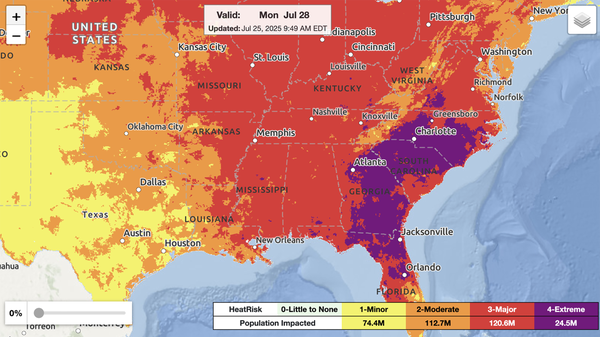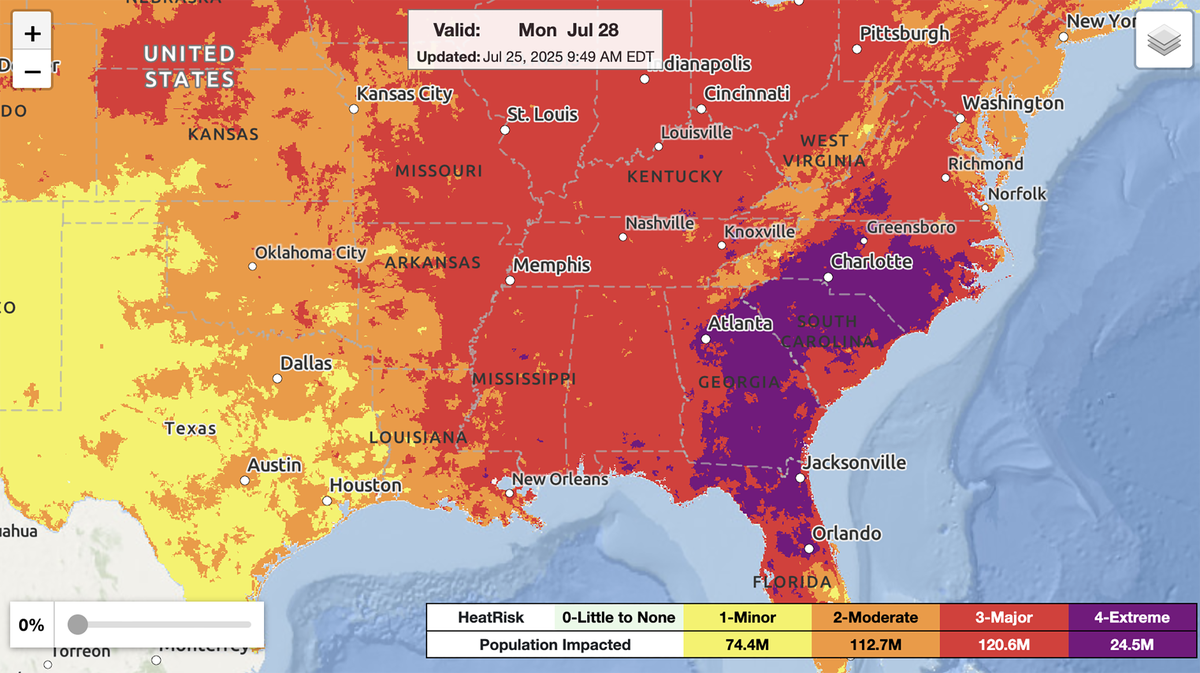Scorching Heat Dome Grips Eastern U.S., with No Relief in Sight
Tens of millions of people are already under heat alerts, and the worst is yet to come

HeatRisk forecast for July 28, 2025. The NWS HeatRisk is an experimental color-numeric-based index that provides a forecast risk of heat-related impacts to occur over a 24-hour period.
National Weather Service/NOAA
A lingering heat dome over the eastern half of the U.S. is putting tens of millions of people in sweltering conditions, with the worst still to come.
On July 25 the East Coast is bearing the brunt of the heat, with more than 80 million people at major or extreme risk of heat effects, according to the National Weather Service, a branch of the National Oceanic and Atmospheric Administration. And as the coming days unfold, the southeastern U.S. will see several days of potentially record-setting heat, with nearly 150 million people—almost half the nation’s population—at major or extreme risk of heat effects on July 28.
“Even though it’s midsummer, this is pretty notable,” said Bryan Jackson, a meteorologist at the NWS Weather Prediction Center in College Park, Md., in an interview with Scientific American earlier this week.
On supporting science journalism
If you’re enjoying this article, consider supporting our award-winning journalism by subscribing. By purchasing a subscription you are helping to ensure the future of impactful stories about the discoveries and ideas shaping our world today.
READ MORE: Heat Is More Than Just Temperature—Here’s How We Measure It
Heat domes occur when a high-pressure mass of air traps heat in place. “Essentially, it’s a cap on the atmosphere that typically leads to warmer temperatures but also leads to sunnier days and less chance of precipitation,” says Zack Taylor, also a meteorologist at the NWS Weather Prediction Center.
For people under the sweltering influence of a heat dome, the weather pattern can be excruciatingly tedious to endure, Jackson told Scientific American. “Heat domes are generally slow to form and slow to dissipate,” he said.
The current event will be long-lived even for a heat dome. Although the system will only briefly raise temperatures along the East Coast on July 25, it will then settle over the Southeast and grow, with potentially record-breaking heat conditions expected to continue through around July 31.
The Southeast’s tendency toward high humidity at this time of year traditionally keeps air temperatures somewhat lower, Taylor adds, reducing the frequency of 100-degree-Fahrenheit (38-degree-Celsius) days. But that might not hold true this week: in the next few days, cities such as Columbia, S.C., and Tallahassee, Fla., may tie or break daily record temperatures in the low 100s F. And the high humidity will mean that temperatures can’t fall much overnight, offering people little respite from the dangerous conditions.
Overall, huge portions of the U.S. population will struggle with heat in the coming days. The National Weather Service’s HeatRisk map includes five categories of risk, from little to none up to extreme, which it describes as “rare and/or long-duration extreme heat with no overnight relief.” More than 24 million people will experience those conditions on July 28 and 30, with more than 30 million people facing extreme heat risk on July 29. In addition, more than 100 million people will face major heat risk on July 28 and 29.
Heat can be deadly: in 2023 the Centers for Disease Control and Prevention reported 2,325 deaths as heat-related—more than double the number in 1999, according to a study published last year. And as climate change continues to unfold, dangerous heat conditions will become ever more prevalent.
If you live in an affected area, check out our science-backed tips for staying healthy in extreme heat and for keeping your house cool.




